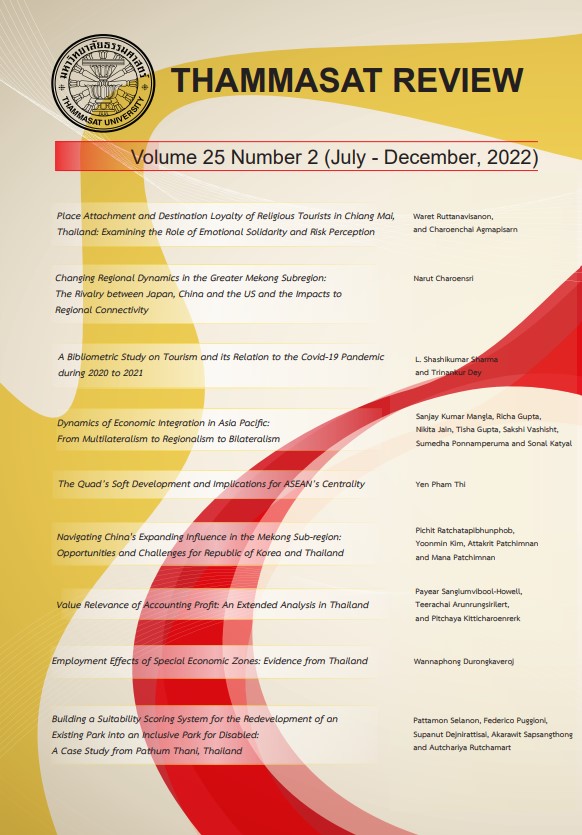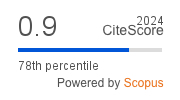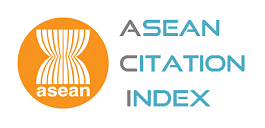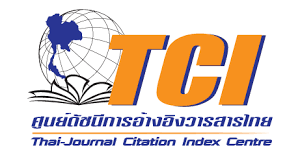Dynamics of Economic Integration in Asia Pacific: From Multilateralism to Regionalism to Bilateralism
Keywords:
Economic integration, Free Trade Agreements (FTAs), Regional Trade Agreements (RTAs), Asia – Pacific region (APAC), Export volumesAbstract
With its dynamic economy and rich cultural variety, the Asia Pacific area is fast expanding in importance and is poised to play a key and essential role in the globe as the twenty-first century unfolds. The region's ability and desire to cooperate with one another across a wide variety of activities will be a significant component in its success. In terms of regional economic integration, the Asia-Pacific area has been a late starter. In comparison to North America and Western Europe, Asia's regional economic integration is still in its infancy. Accordingly, this paper explore that how economic integration has shaped the Asia – Pacific region in last 50-60 years by studying the effects of various regional trade agreements on the export volumes of the significant countries of this region. Further, the comparative analysis is undertaken in terms of various clauses or provisions among major regional and bilateral groups of Asia – Pacific. Additionally, the paper will analyze the emerging dynamics of this region focusing on the role played by small Pacific Islands and India in development of this region. Finally, we conclude that increasing regional and bilateral trade agreements among Asia Pacific countries are shaping the current scenario of economic integration in this region and also leading to increasing the share of exports volumes among themselves, resulting in economic growth worldwide.
References
Alvarez, J. E. (2000). Multilateralism and Its Discontents. European Journal of International Law, 11(2), 393-411.
APTIAD. (2012). Trade agreements and arrangements in the Pacific subregion, APTIAD Briefing Note.
Bhagwati, J. N. (1995). US Trade Policy: The Infatuation with FTAs. Department of Economics, Columbia University. https://doi.org/10.7916/D8CN7BFM
Breslin, S. (2010). Comparative theory, China, and the future of East Asian regionalism(s). Review of International Studies, 36(3), 709-729. http://www.jstor.org/stable/ 40783292
Burri, M., & Polanco, R. (2020). Digital Trade Provisions in Preferential Trade Agreements: Introducing a New Dataset. Journal of International Economic Law, 23(1), 187-220. https://doi.org/10.1093/jiel/jgz044
Carmichael, C. (2019). SPARTECA, PICTA, and the WTO: How the Pacific Island States are Impacted by Free Trade Agreements. University of Prince Edward Island
Green, M. J., & Gill, B. (2009). Asia's New Multilateralism: Cooperation, Competition, and the search for Community. Columbia University Press.
Heydon, K., & Woolcock, S. (2009). The Rise of Bilateralism: Comparing American, European and Asian approaches to preferential trade agreements. United Nations University Press.
Kanungo, A. K. (2009). Jagdish Bhagwati, Termites in the Trading System: How Preferential Agreements Undermine Free Trade. International Studies, 46(1&2), 246-252. In Oxford University Press.
Kathuria, S. (Ed.). (2018). A glass half full: The promise of regional trade in South Asia. World Bank Publications.
Katzenstein, P. J. (2005). A World of Regions: Asia and Europe in the American Imperium. Cornell University Press. https://doi.org/10.7591/9781501700385
Kawai, M., & Wignaraja, G. (2008). Regionalism as an Engine of Multilateralism: A Case for a Single East Asian FTA. ADB Working Paper Series on Regional Economic Integration, No. 14
Kawai, M., & Wignaraja, G. (Eds.) (2011). Asia’s Free Trade Agreements: How is Business Responding? Edward Elgar Publishing.
Kim, C. W. (2015). Building Multilateralism on Bilateralism: Evidence from Networked Governance of FDls in Asia. Asian Perspective, 39(2), 325-355.
Krugman, P. (1989, May). Is Bilateralism Bad? Retrieved from http://www.nber.org/papers/w2972
Low, L. (2003). Multilateralism, Regionalism, Bilateral and Cross-regional Free Trade Arrangements: All Paved with Good Intentions for ASEAN? Asian Economic Journal, 17(1), 65-86.
Mitchell, A. D., & Mishra, N. (2017). Data at the Docks: Modernizing International Trade Law for the Digital Economy. Vanderblit Journal of Entertainment and Technology Law, 20(4), 1073-1134.
Nguyen, H. Q., & Nguyen, V. K. (2019). Multilateral Mechanisms in the Asia – Pacific Region: Impact on ASEAN’s Centrality and Implications for Vietnam. Journal of the United Service Institution of India.
Piquet, H. S. (1950). The Customs Union Issue. By Jacob Viner. American Political Science Review, 44(4), 1055-1055.
Rahman, M. N., & Rahman, N. (2022). Exploring digital trade provisions in Regional Trade Agreements (RTAs) in times of crisis: India and Asia-Pacific countries. Asia and the Global Economy, 2(2).
Rana, P. B. (2006). Economic Integration in East Asia: Trends, Prospects, and a Possible Roadmap. Working Paper Series on Regional Economic Integration No.2. Asian Development Bank.
Ravenhill, J. (2008). The New Trade Bilateralism in East Asia. In Kent E. Calder & Francis Fukuyama (Eds.), East Asian Multilateralism: Prospects for Regional Stability (pp. 78-105). Baltimore, MD: John Hopkins University Press.
Ravenhill, J. (2010). The ‘new East Asian regionalism’: A political domino effect. Review of International Political Economy, 17(2), 178-208
Shiraishi, T. & Katzenstein, P. J. (2018). Network Power: Japan and Asia. Cornell University Press.
Ravenhill, J. (2010). The ‘new East Asian regionalism’: A political domino effect. Review of International Political Economy, 178-208.
Downloads
Published
How to Cite
Issue
Section
License
Copyright (c) 2022 Thammasat Review

This work is licensed under a Creative Commons Attribution-NonCommercial-NoDerivatives 4.0 International License.
The opinions and ideas expressed in all submissions published in Thammasat Review are solely that of the author(s) and do not necessarily reflect that of the editors or the editorial board.
The copyright of all articles including all written content and illustrations belong to Thammasat Review. Any individuals or organisation wishing to publish, reproduce and distribute a particular manuscript must seek permission from the journal first.








